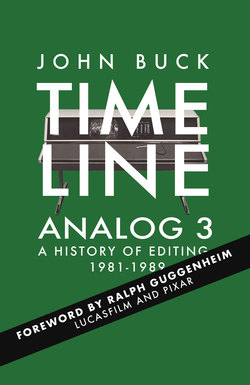Читать книгу Timeline Analog 3 - John Buck - Страница 21
На сайте Литреса книга снята с продажи.
BARKER
ОглавлениеWhile engineers and scientists formed the initial teams to build the next generation editing systems, a new group rose to sell the systems to an often sceptical marketplace. A future editing 'evangelist' graduated from business school and moved into post-production. Bob Slutske became director of marketing at the Hollywood based post-production company, Compact Video.
Compact had every piece of equipment you could imagine. It had a 16mm lab, offline and video editing for audio and video, satellites and videotape. It was a great place to learn about what clients wanted in videotape and in electronic editing.
The recently unemployed Ron Barker decided to tour Compact Video and other West Coast facilities to see where the market was headed and what opportunities were present.
I was unable to get access to Adrian Ettlinger’s system and then Clark Higgins organized a meeting for me with Coppola in his San Francisco office the following week, where I found Francis to be uninterested in the details but committed to using technology in film making. Clark then took me over to Lucasfilm, where he had worked but they weren’t saying a word about what they were doing.
It was obvious to me after the fact finding mission, that the creative people wanted nothing to do with the strict regimes of linear editing defined by timecode and conversely, the engineers and online editors were primarily focused on developing the conventional 'linear systems'. It was then that I realized I was onto something. That I had something to contribute to editing.
On his return east, Barker evolved his editing system concept further, using experiences from his wide and varied engineering career. However it was a different activity that provided the catalyst. The tactile nature of film editing reminded him of the intuitive control of the remote control model helicopters he had flown. Barker imagined a machine that was the polar opposite of a CMX linear system.
It was to be a system that provided an editor with visual cues and yet was driven by highly specialised hand controls. After his ‘eureka’ moment Barker worked from a spare office at equipment maker Adams-Smith.
They lent me a room next to their conference area for six weeks and my secretary Beverley and a few others who I had convinced to come across from BTX worked away. All I had in those days was a Betamax machine and some tiny televisions that I bought from the Sears department store.
You see I chose those decks because the Betamax machines had a remarkable feature that VHS decks and most professional systems didn’t have, they had a still frame ability. I thought if you could use that still frame as a method of identifying a clip whether that was the in and out frames or a method of sorting clips. I wasn’t exactly sure.
